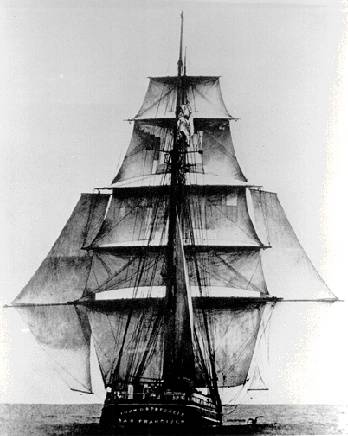Death Ships: Difference between revisions
m (1 revision(s)) |
mNo edit summary |
||
| (2 intermediate revisions by one other user not shown) | |||
| Line 1: | Line 1: | ||
'''<font face = arial light> <font color = maroon> <font size = 3>Unfinished History</font></font> </font>''' | |||
''by Dr. Weirde'' | |||
[[Image:chinatwn$clipper-ship-(bw).jpg]] | [[Image:chinatwn$clipper-ship-(bw).jpg]] | ||
View of a Clipper Ship under sail | '''View of a Clipper Ship under sail''' | ||
'' | ''Photo: San Francisco Maritime Museum'' | ||
The Chinese in San Francisco remained so attached to their homeland that they didn't want to be buried anywhere else. For years, "death ships" laden with Chinese corpses, bones, and ashes plied the Pacific, returning the remains of Chinese immigrants to their native soil. In 1858, for example, the ship ''Asia'' sailed from San Francisco to Hong Kong, bearing the embalmed bodies of 321 Chinese in its hold. The same year, the American clipper ''Flying Cloud'' sailed the same route, carrying 200 Chinese corpses as its main cargo. It wasn't until the 20th century, with the earthquake and fire of 1906 and the fall of the Manchu Empire in 1912, that the majority of Chinese here decided to stay and make San Francisco their permanent home ... both in life ''and'' in death. | |||
[[A Glittering Ghetto | Prev. Document]] [[The Six Companies | Next Document]] | |||
[[ | [[category:Chinese]] [[category:Chinatown]] [[category:1850s]] [[category:1910s]] | ||
Latest revision as of 13:32, 29 March 2013
Unfinished History
by Dr. Weirde
View of a Clipper Ship under sail
Photo: San Francisco Maritime Museum
The Chinese in San Francisco remained so attached to their homeland that they didn't want to be buried anywhere else. For years, "death ships" laden with Chinese corpses, bones, and ashes plied the Pacific, returning the remains of Chinese immigrants to their native soil. In 1858, for example, the ship Asia sailed from San Francisco to Hong Kong, bearing the embalmed bodies of 321 Chinese in its hold. The same year, the American clipper Flying Cloud sailed the same route, carrying 200 Chinese corpses as its main cargo. It wasn't until the 20th century, with the earthquake and fire of 1906 and the fall of the Manchu Empire in 1912, that the majority of Chinese here decided to stay and make San Francisco their permanent home ... both in life and in death.

